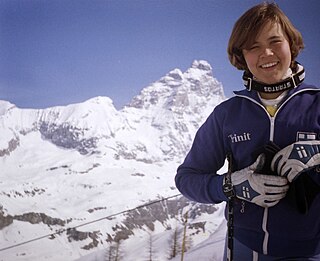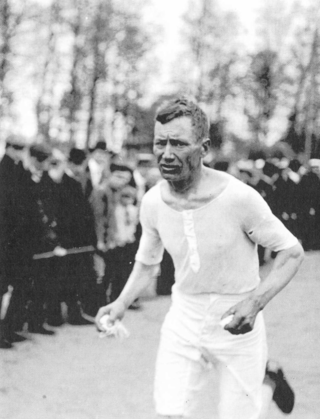Related Research Articles

Finnicization is the changing of one's personal names from other languages into Finnish. During the era of National Romanticism in Finland, many people, especially Fennomans, finnicized their previously Swedish family names.

Jani Petteri Toivola is a Finnish actor, dancer, author and an ex-politician. He studied in HB Acting Studio, New York City in 1999–2002. He has performed in several dance works, television series and plays. Toivola is also openly gay. His father is Kenyan and his mother is Finnish.

Sara Kristiina Mustonen was a Finnish alpine skier. She is the youngest skier ever to win the Finnish alpine ski championship with her gold medal in the women's slalom in 1977 when she was only 14 years old.

Ursa Astronomical Association is the largest astronomical association in Finland. Ursa was founded on 2 November 1921. Founding members include a renowned Finnish astronomer Yrjö Väisälä. In 1926 Ursa established the Ursa Observatory in Kaivopuisto district of Helsinki. In 2007 the Tähtikallio Observatory & Education Center was established in Artjärvi, its current equipment includes an Astrofox 36" Folded Newtonian Open tube telescope, an Alluna 16" Ritchey-Chrétien telescope, a Meade 16" LX200GPS Schmidt-Cassegrain telescope, a Sky-Watcher ED 120mm refractor telescope fitted with a Baader AstroSolar Solar Filter and a piggybacked Coronado SolarMax 40 H-Alpha telescope. Ursa's primary functions include advancing amateur astronomy and astronomical education. They have also published a magazine Tähdet ja avaruus since 1971. Anyone can join Ursa for an annual fee.

Pirkko Helena Saisio is a Finnish author, actress and director. She has also written under the pen names Jukka Larsson and Eva Wein. Saisio has a broad literary output, dealing with many kinds of texts from film screenplays all the way to librettos for the ballet. Her novel Betoniyö (1981) was adapted into a feature film Concrete Night in 2013 by Pirjo Honkasalo.

Toivo Nestori Aro was a Finnish sportsleader and an aquatics athlete, who won 10 Finnish championships.

Heikki Huttunen was a Finnish sport shooter who competed at the 1908, the 1912 and the 1924 Summer Olympics and won five Finnish national championship golds.
Tähdet ja avaruus is a Finnish science magazine which publishes recent developments, news and interviews in astronomy, space technology, cosmology and amateur astronomy. It is the largest circulation astronomy magazine in northern Europe.

Laskiainen is the Finnish celebration of what is known in the English-speaking world as Shrove Tuesday. It is often described as a "mid-winter sliding festival".

Fundamental Astronomy (1984–2017) is an astronomy textbook by Finnish author Hannu Karttunen of University of Turku; Pekka Kröger and Heikki Oja of University of Helsinki; Markku Poutanen of Finnish Geodetic Institute; and Karl Johan Donner of University of Helsinki. The first edition was published in Finnish by Ursa, Helsinki, 1984, and later published in English by Springer. The 6th edition was published in 2017. It contains 548 pages and is illustrated with more than 419 images, including 34 color plates. There are many pages on the solar system, the Milky Way, galaxies, and cosmology.

Tuomas Kyrö is a Finnish author and cartoonist. He has written novels, columns, causeries and plays and drawn comics and cartoons.

Karl Maurits "Kalle" Nieminen was a Finnish long-distance runner, who competed in the 1908 Summer Olympics.
Heikki Sakari Kalha was a Finnish diplomat and a varatuomari.

Christmas in Finland begins, as is commonplace on public holidays in Finland, on Christmas Eve. Especially the evening of Christmas Eve has become the most important day of the Christmas period, and is nowadays a paid holiday in most workplaces. Unlike on other public holidays, public transportation stops almost completely on the afternoon of Christmas Eve in Finland. The Christmas period ends on Epiphany.

Finland uses Eastern European Time (EET) during the winter as standard time and Eastern European Summer Time (EEST) during the summer as daylight saving time. EET is two hours ahead of coordinated universal time (UTC+02:00) and EEST is three hours ahead of coordinated universal time (UTC+03:00). Finland adopted EET on 30 April 1921, and has observed daylight saving time in its current alignment since 1981 by advancing the clock forward one hour at 03:00 EET on the last Sunday in March and back at 04:00 EET on the last Sunday in October, doing so an hour earlier for the first two years.

The Finnish People's Organisation was a bilingual Nazi party founded by Jaeger Captain Arvi Kalsta. Supporters of the movement were also called Kalstaites after the leader. The inaugural meeting of the organization was held in March 1933 and was attended by about 500 members. SKJ published the magazines Herää Suomi, Hakkorset and Hakaristi. In addition to its own magazines, the organization had its own publishing house Vasara. The organization wore a brown uniform like the Sturmabteilung of the German Nazi Party, and used the greeting "Finland Awake!"
Niilo Vilho Rauvala was a Finnish engineer and the chairman of the far-right Lalli Alliance of Finland and the Nazi Party of Finnish Labor in the 1930s and 1940s.

Aarne Emil Kauhanen was a Finnish officer of the Central Detective Police (EK) and its successor, the State Police (ValPo), with special responsibility for aliens in the 1930s and 1940s. During the Continuation War, he acted as a liaison between the Finnish and Nazi German police authorities and was involved in the recruitment of the Finnish SS Battalion. Kauhanen also beat and tortured Jewish refugees during interrogations. After the war, he escaped to South America, where Kauhanen died in unclear circumstances in 1949. According to a memoir, one of his victims recognized and later shot him.
Eva Isaksson is a Finnish librarian and non-fiction writer, with interests in astronomy and feminism. She was employed at the Helsinki University Observatory from 1981 and became a tenured astronomy librarian in 1998. In 2010, she transferred with the merger of the physics and astronomy departments to the Kumpula Science Library, on the Kumpula Campus. Isaksson and has been involved with the Finnish LGBT and pacifist movements since the 1970s. She produced the Lesbian Information Secretariat Newsletter for the International Lesbian Information Service from 1981 to 1983 and in the 1990s, began to create on-line platforms for lesbians to network. Recognizing the potential of on-line communication she established training programs to teach women at the university how to use computer technology to network with each other and to further their research goals. She was recognized in 1999 with the Maikki Friberg Equality Prize, an award given by the University of Helsinki to recognize persons who have furthered gender equality.
References
- 1 2 Ajantasan viikon vieras: Heikki Oja, YLE 1 April 2006. Accessed on 2 March 2007.
- ↑ Oja, Heikki: Almanakkatomiston alkuajoilta, almanac office of the University of Helsinki 1 December 2014. Accessed on 25 December 2015.
- 1 2 Tiedonjulkistamisen elämäntyöpalkinto professori emeritus Heikki Ylikankaalle, Finnish ministry for education and culture 29 April 2014. Accessed on 25 December 2015.
- ↑ Lahtonen, Katariina: Sinihampaan riimu älypuhelimessa. Lounais-Hämeen joulu, 2015, pp. 37-38. Forssa: Association for homesteads and museums in Southwestern Tavastia.
- ↑ Aikakirja 2013, almanac office of the University of Helsinki. Accessed on 25 December 2015.